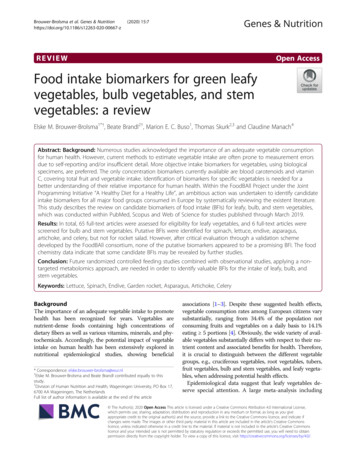
Transcription
Brouwer-Brolsma et al. Genes & z(2020) 15:7REVIEWOpen AccessFood intake biomarkers for green leafyvegetables, bulb vegetables, and stemvegetables: a reviewElske M. Brouwer-Brolsma1*†, Beate Brandl2†, Marion E. C. Buso1, Thomas Skurk2,3 and Claudine Manach4Abstract: Background: Numerous studies acknowledged the importance of an adequate vegetable consumptionfor human health. However, current methods to estimate vegetable intake are often prone to measurement errorsdue to self-reporting and/or insufficient detail. More objective intake biomarkers for vegetables, using biologicalspecimens, are preferred. The only concentration biomarkers currently available are blood carotenoids and vitaminC, covering total fruit and vegetable intake. Identification of biomarkers for specific vegetables is needed for abetter understanding of their relative importance for human health. Within the FoodBAll Project under the JointProgramming Initiative “A Healthy Diet for a Healthy Life”, an ambitious action was undertaken to identify candidateintake biomarkers for all major food groups consumed in Europe by systematically reviewing the existent literature.This study describes the review on candidate biomarkers of food intake (BFIs) for leafy, bulb, and stem vegetables,which was conducted within PubMed, Scopus and Web of Science for studies published through March 2019.Results: In total, 65 full-text articles were assessed for eligibility for leafy vegetables, and 6 full-text articles werescreened for bulb and stem vegetables. Putative BFIs were identified for spinach, lettuce, endive, asparagus,artichoke, and celery, but not for rocket salad. However, after critical evaluation through a validation schemedeveloped by the FoodBAll consortium, none of the putative biomarkers appeared to be a promising BFI. The foodchemistry data indicate that some candidate BFIs may be revealed by further studies.Conclusion: Future randomized controlled feeding studies combined with observational studies, applying a nontargeted metabolomics approach, are needed in order to identify valuable BFIs for the intake of leafy, bulb, andstem vegetables.Keywords: Lettuce, Spinach, Endive, Garden rocket, Asparagus, Artichoke, CeleryBackgroundThe importance of an adequate vegetable intake to promotehealth has been recognized for years. Vegetables arenutrient-dense foods containing high concentrations ofdietary fibers as well as various vitamins, minerals, and phytochemicals. Accordingly, the potential impact of vegetableintake on human health has been extensively explored innutritional epidemiological studies, showing beneficial* Correspondence: elske.brouwer-brolsma@wur.nl†Elske M. Brouwer-Brolsma and Beate Brandl contributed equally to thisstudy.1Division of Human Nutrition and Health, Wageningen University, PO Box 17,6700 AA Wageningen, The NetherlandsFull list of author information is available at the end of the articleassociations [1–3]. Despite these suggested health effects,vegetable consumption rates among European citizens varysubstantially, ranging from 34.4% of the population notconsuming fruits and vegetables on a daily basis to 14.1%eating 5 portions [4]. Obviously, the wide variety of available vegetables substantially differs with respect to their nutrient content and associated benefits for health. Therefore,it is crucial to distinguish between the different vegetablegroups, e.g., cruciferous vegetables, root vegetables, tubers,fruit vegetables, bulb and stem vegetables, and leafy vegetables, when addressing potential health effects.Epidemiological data suggest that leafy vegetables deserve special attention. A large meta-analysis including The Author(s). 2020 Open Access This article is licensed under a Creative Commons Attribution 4.0 International License,which permits use, sharing, adaptation, distribution and reproduction in any medium or format, as long as you giveappropriate credit to the original author(s) and the source, provide a link to the Creative Commons licence, and indicate ifchanges were made. The images or other third party material in this article are included in the article's Creative Commonslicence, unless indicated otherwise in a credit line to the material. If material is not included in the article's Creative Commonslicence and your intended use is not permitted by statutory regulation or exceeds the permitted use, you will need to obtainpermission directly from the copyright holder. To view a copy of this licence, visit http://creativecommons.org/licenses/by/4.0/.
Brouwer-Brolsma et al. Genes & Nutrition(2020) 15:795 prospective studies recently revealed that a high intake of leafy green vegetables was associated with a reduced risk of coronary heart disease (10 studies, RR 0.83, 95% CI 0.75–0.91), stroke (4 studies, RR 0.88,95% CI 0.81–0.95), and a 24% reduction in all-causemortality for each 100 g/day increment in intake [1]. Inanother meta-analysis focusing on associations betweenall fruit and vegetable subtypes and type 2 diabetes, onlygreen leafy vegetables (highest vs lowest intake categories) were associated with a significant risk reduction (RR 0.84, 0.74–0.94) [2]. Spinach (Spinacia oleracea,Amaranthaceae family) represents a main member ofleafy vegetables and has been shown to decrease postprandial arterial stiffness and systolic blood pressure inrandomized controlled trials [5–7]. Moreover, gardenrocket (Eruca sativa), a green-leafy vegetable from theBrassicaceae, has been proposed to possess anti-oxidative,anti-inflammatory, and anti-ulcer properties [8, 9]. Asteraceae is another botanical family of leafy vegetables representing amongst others endive and lettuce. Bulb and stemvegetables have been less extensively studied than leafyvegetables and constitute a rather heterogenous groupincluding in particular celery, artichoke and asparagus.Celery (Apium graveolens L.) has been proposed to possess anti-oxidative and anti-inflammatory potency [10,11], whereas artichoke (Cynara scolymus) received attention through its potential beneficial impact on LDLcholesterol, endothelial NOS expression, and hepatodigestive function [12]. Asparagus (Asparagus officinialiswith Asparagales as the botanical family) on its turn is arich source of asparagine, potassium, vitamin C, and antioxidative glycolipids [13].Up to now, vegetable intake in the epidemiologicalstudies was generally assessed using traditional selfreported dietary assessment methods, such as food diaries, 24 h recalls and food frequency questionnaires(FFQs). Although these self-report dietary assessmentmethods provide valuable information, they are prone tomeasurement error and burdensome for both participants and researchers. Bingham and colleagues observedthat the intake of fruits and vegetables assessed by FFQwas almost 2-fold higher compared with a food diary [14].At the same time, the association between plasma vitaminC and the intake of fruits and vegetables was strongerwhen assessed by food diary than by FFQ, suggesting ahigher degree of measurement error with the FFQ thanwith the food diary [14]. However, the processing of selfadministered FFQs is much more convenient than thehandling of diaries or recalls. To get insight in the habitualintake of commonly consumed foods, diaries and 24 h recalls need to be repeated at least 3 times [15] and evenmore frequently to capture specific types of vegetablesand associated variety-specific nutrients [16]. Therefore,FFQs are usually the method of choice in largePage 2 of 12observational cohort studies. However, compared to diaries and 24 h recalls, FFQs are usually more restrained withrespect to the variety of foods queried as well as portionsize estimations. Moreover, both FFQs and recalls areprone to measurement error resulting from socially desirable answers and errors in food composition tables [17–20].Therefore, the use of candidate biomarkers of food intake (BFIs), i.e., objective food consumption markers inbiological specimens such as urine or blood, is gaininginterest, even though there are still very few wellvalidated dietary intake biomarkers [21]. The intake oftotal fruit and vegetable consumption is frequently estimated using blood vitamin C or carotenoids (i.e., plasmaα- and β-carotene, β-cryptoxanthin, and lutein) [22, 23].However, the use of these biomarkers does not allow todistinguish between the types of fruit and vegetablesconsumed. Integrating the data as obtained by one ormore of the traditional dietary assessment methods withvalidated BFIs data may eventually facilitate nutritionalresearch by resulting in more precise intake estimatesthat have the ability to distinguish between the specificvarieties of fruits and vegetables consumed [24].To facilitate the identification and evaluation of newcandidate BFIs, the Food Biomarker Alliance (FoodBAll)[21], a project funded by the Joint Programming Initiativea Healthy Diet for a Healthy Life, established guidelines toconduct a literature search dedicated to food intake biomarkers [25] and to evaluate their level of validation usinga set of consensus criteria [26]. The guidelines were applied for all major food groups: fruit and vegetables, meats,fish, and other marine foods, dairy products, cereals andwhole grains, alcoholic and non-alcoholic beverages, vegetable oils, nuts, and spices and herbs (http://foodmetabolome.org/wp3) [27–36]. The present article presents theresults of the in depth exploration of possible biomarkersof intake for green leafy vegetables (lettuce, spinach, endive, and garden rocket) as well as bulb and stem vegetables (artichoke, asparagus, celery).Material and methodsSelection of vegetable varietiesIn order to cover the major varieties of vegetables consumed in Europe, FoodBAll aimed to cover cruciferousvegetables, root vegetables, tubers, leafy vegetables, fruitvegetables, and bulb and stem vegetables. In the presentreview, we focus on the most widely consumed leafyvegetables (lettuce, spinach, endive, garden rocket), andbulb and stem vegetables (asparagus, celery stalk, andartichoke). Herbs such as parsley, dill, basil, or peppermint and leafy cruciferous vegetables such as kale andcabbage are considered in another FoodBAll review inpreparation.
Brouwer-Brolsma et al. Genes & Nutrition(2020) 15:7Literature search to identify putative BFIsTo identify relevant studies on leafy vegetables and bulband stem vegetables, an extensive literature search wasconducted following the Biomarker of Food Intake Reviews (BFIRev) methodology as proposed previously [25]built on the PRISMA statement (Preferred ReportingItems for Systematic reviews and Meta-Analyses).Briefly, a primary search was performed in the three databases Scopus, PubMed central, and Web of Sciencewith the name of the specific vegetables and its botanicalgenus, i.e, (lettuce OR lactuca sativa OR escarole OR frisée), (spinach OR spinacia oleracea), (endive OR cichorium endivia), (garden rocket OR eruca sativa OR rucolaOR rocket salad OR arugula OR rucoli OR rugula ORcolewort roquette), (asparagus OR asparagus officinalis),(artichoke OR cynara cardunculus OR cynara scolymus),(celery OR apium graveolens) along with the commonkeywords: AND (urine OR plasma OR serum OR excretion OR blood) AND (human* OR men OR women ORpatient* OR volunteer* OR participant*) AND (Biomarker* OR marker* OR metabolite* OR biokinetics ORbiotransformation OR bioavailability OR ADME) AND(intake OR meal OR diet OR ingestion OR administration OR consumption OR eating OR drink*). Keywordswere used in the fields [Topic], [All fields] and [ArticleTitle/Abstract/Keywords] for Web of Science, PubMed,and Scopus, respectively. All searches were carried outin March 2017 and updated in March 2019. Only papersin English language were considered eligible; no restriction was applied with respect to the publication date.Human observational studies (cohort, case-control,cross-sectional studies) and human intervention studies(randomized controlled trials, acute, short-term, or longterm studies) were considered eligible. After duplicatesremoval, a first selection of papers was performed according to abstract and title relevance, thereafter fulltext screening was performed.Evaluation of the identified candidate biomarkersThe quality of the individual candidate BFIs was assessed byevaluating their plausibility and specificity, dose-response,time-response, robustness, reliability, stability, performance,and reproducibility of their analysis method [26]. The nameof the potential biomarkers and their synonyms were queried in the previously mentioned databases in combinationwith AND (biomarker* OR marker* OR metabolite* ORbiokinetics OR biotransformation OR pharmacokinetics ORbioavailability OR ADME) to collect the relevant information for each identified candidate biomarker. In addition, thedatabases HMDB (https://www.hmdb.ca), FooDB (http://foodb.ca/), Phenol-Explorer (http://phenol-explorer.eu/),Dictionary of Food Compounds lSearch.xhtml), Duke’s phytochemical and ethnobotanical databases (https://phytochem.Page 3 of 12nal.usda.gov/phytochem/search), eBASIS, (http://ebasis.eurofir.org/Default.asp), Knapsack (http://kanaya.naist.jp/knapsack jsp/top.html) and PhytoHub (http://phytohub.eu)were searched to identify all possible sources of each candidate biomarker and thus check its specificity. The validationlevel of the candidate BFIs was evaluated via the pre-definedcriteria set by Dragsted and colleagues [26], which werebased on eight questions related to the biological and analytical aspects: Q1: is the marker compound plausible as a specific BFI for the food or food group (chemical/biologicalplausibility)? Q2: is there a dose-response relationship atrelevant intake levels of the targeted food (quantitative aspect)? Q3: is the biomarker kinetics described adequately tomake a wise choice of sample type, frequency, and time window (time-response)? Q4: has the marker been shown to berobust after intake of complex meals reflecting dietary habitsof the targeted population (robustness)? Q5: has the markerbeen shown to compare well with other markers or questionnaire data for the same food/food group (reliability)?Q6: is the marker chemically and biologically stable duringbio specimen collection and storage, making measurementsreliable and feasible? Q7: are analytical variability (CV%), accuracy, sensitivity, and specificity known as adequate for atleast one reported analytical method? Q8: has the analysisbeen successfully reproduced in another laboratory (reproducibility)? This set of criteria therefore reflects the currentlevel of validation of that particular compound and pinpoints the additional research needed to increase itsvalidation.Results and discussionLeafy vegetablesThe primary literature search on leafy vegetables resultedin 361 articles. After removal of duplicates, 247 publications were screened based on their title and abstract, 108publications underwent full-text assessment, and eventually 61 publications were included in this review. In March2019, the primary literature search was updated. The threedatabases yielded 34 new hits of which 24 remained afterremoval of duplicates, ten publications remained aftertitle/abstract screening and four were selected based onthe full-text assessment (Fig. 1). Main reasons for exclusion were that the: (1) intake assessment was too general(i.e., vegetable intake), (2) focus was on the effect of the intake on health-related markers, and/or (3) exposure in anutritional intervention study was not only green leafyvegetables. Finally, the two searches combined resulted in65 potentially relevant papers that provided data on theintake of one or more of the selected leafy vegetables (lettuce n 7, endive n 1, rocket salad n 1, spinach n 65) and measured one or more related compounds inbody tissue, such as plasma, urine, and/or feces. The maincharacteristics of these studies are displayed in Additionalfile 1: Table S1.
Brouwer-Brolsma et al. Genes & Nutrition(2020) 15:7Page 4 of 12Fig. 1 Flow diagram of study selectionA wide range of metabolites were reported in biofluidsafter consumption of leafy vegetables. However, as discussed below, many of these metabolites have other dietary origins and were therefore not specific enough to beretained as candidate BFIs. Carotenoids and their derivatives and conjugates were the most commonly reportedmetabolites after consumption of leafy vegetables. Carotenoids belong to the family of tetraterpenoids; whereoxygen-containing carotenoids are called xanthophylls(e.g., lutein and zeaxanthin) and unoxygenated carotenoids are called carotenes (e.g., α- and β-carotene, andlycopene). As carotenoids are commonly found in a widerange of vegetables, they were considered unspecific andas such not retained as candidate BFIs. To illustrate, acomparative study across five European countriesshowed that spinach was the food contributing most tothe total lutein intake in France, Spain, and theNetherlands (i.e., 30–34%) [37]. Lettuce was the secondmajor food contributing to lutein intake in France andSpain (i.e., 8–16%) [37]. However, lutein is also present inegg yolk, pistachio, red pepper, pea, broccoli, corn, andcommon herbs [38, 39]. Additionally, spinach has beenshown to be a major food contributing to the total βcarotene intake (12-26%). Though α- and β-carotene areprimarily obtained through the consumption of carrots[37]. Besides the studies on carotenoids, two observationalstudies reported that vitamin K1 (phylloquinone) was associated with the consumption of spinach and lettuce [40,41]. However, phylloquinone is widely distributed in allphotosynthetic plants, where it serves as a cofactor forphotosynthesis and is also available as dietary supplement[42]. Moreover, neither vitamins nor nitrate or phosphatewere retained as candidate biomarkers for BFIs as thesecomponents are common in a range of other foods as well[43, 44]. Finally, some intervention studies reported an increased urinary oxalate excretion after consumption of
Brouwer-Brolsma et al. Genes & Nutrition(2020) 15:7spinach. Indeed, it is well-known that spinach should berestricted by individuals at high risk of calcium oxalatekidney stones [45]. However, beetroots, rhubarb, chocolate, wheat bran, almonds, and peanuts are other important sources of oxalic acid, making it not specific enoughto represent a promising candidate biomarker of intakefor spinach [45].After excluding articles reporting on obviously nonspecific biomarkers, six articles provided data on candidate BFIs of green leafy vegetables (Table 1). Theretained articles included five acute single-dose studiesand one cross-over intervention focusing on either urinary and/or blood-based biomarkers (i.e., plasma). Samplesizes were small, ranging from 3 up to 11 participants.Five studies used a targeted approach; one study applieduntargeted metabolomics. In total, 9 candidate BFIs wereidentified for spinach, 2 for lettuce, and 2 for endive.None of the selected articles reported on candidate biomarkers for rocket salad.SpinachSpinach has been considered since ancient times as afood with functional properties that supports healthmaintenance [52, 53]. It is of high nutritional value, withlarge contents of folates, vitamin A, C, and K, and minerals such as iron, magnesium, and manganese, allowinga substantial contribution to their respective recommended dietary allowances when consuming a singleserving [53]. Spinach also provides nitrates that—afterconversion by salivary bacteria and host reductases intonitrites—improve the nitric oxide status and as such hasbeen beneficially related to vascular function and bloodpressure [6, 7]. Spinach also contains a number of phytochemicals, including chlorophylls, carotenoids (lutein,neoxanthin, zeaxanthin), and chloroplast-specific lipids,e.g., mono- and di-galactosyldiacylglycerol (MGDG andDGDG, respectively) and the anionic sulfolipid, sulfoquinovosediacylglycerol (SQDG). It also provides uniqueflavonoids, e.g., derivatives of patuletin, spinacetin, spinatoside, jaceidin, and methylenedioxyflavone [54–56].Of the four identified studies that examined changesin metabolites associated with spinach intake, none hadthe objective to identify BFI (Table 1). Although it isgenerally assumed that chlorophyll derivatives have verylow bioavailability [57], Chao and colleagues (2018) reported on the identification of chlorophyll-related compounds, i.e., pheophytin (FDB007170) and pheophorbide(FDB031104) derivatives, in plasma 3 h following a highacute dose of just-boiled fresh spinach [46]. Pheophytinand pheophorbide are degradation products of chlorophylls that lack the central Mg2 ion and are readily produced during thermal processing or acidification [57]. It iscommonly known that chlorophylls and derivatives areubiquitous in all photosynthetic plants with particularlyPage 5 of 12high levels in leafy green vegetables. Chlorophylls and derivatives are thus unlikely to be sufficiently specific forspinach, even when used in combination with other spinach derived compounds [58].A pilot metabolomic study explored the changes in theurine metabolomes of 10 participants after an acute intake of 200 g spinach in the context of a controlled diet,compared to the intake of 200 g celery, 200 g onion, orto the controlled diet without addition of any vegetable[47]. The principal component analysis score plotshowed a shift in the post-spinach urine metabolomecompared to the control group and intake of other vegetables. However, among the signals discriminating spinach intake, the authors only reported one discriminatingion with m/z 214.15 that was tentatively identified as 4guanidino-butanoic acid with an isoprene modification.When the identification is confirmed, the validation criteria proposed by the FoodBAll consortium BFI will haveto be assessed for this compound. Similar interventionstudies using untargeted metabolomics with large analytical coverage will be of great value to identify other candidate biomarkers of spinach intake, provided that thediscriminating signals can be properly identified.Another selected study was a cross-over interventionwith 3 weeks supplementation that aimed at comparingthe effects of spinach and cheese on the calcium andzinc balance, oxalate excretion, and urinary hydroxyproline in 7 post-menopausal women [48]. An increasedurinary excretion of hydroxyproline (PubChem CID:5810) was reported. However, this compound is a common amino acid and a constituent of collagen that hasalso been suggested as a biomarker for processed meatconsumption and can therefore be excluded as candidatebiomarker for spinach [59].The last relevant study aimed at identifying the polyphenol metabolites recovered in human plasma after ingestionof 5 g freeze-dried 13C-labeled spinach. The main metabolites were a glucuronide and a sulfate of lavone(TMM),andspinacetin-glucuronide-sulfate [49]. The secondary searchin the literature and in various databases (FooDB, PhytoHub, Duke’s phytochemical and ethnobotanical database,Phenol-Explorer, CRC press Dictionary of Food Compounds) revealed that the derivatives of spinacetin andTMM are compounds with a high specificity for spinach.As specificity is an important prerequisite for BFIs, the metabolites of spinacetin and TMM identified in plasma deserve further investigation as putative intake biomarkers,with the examination of the other validation criteria. Suchderivatives of the spinach flavonoids are likely to be alsopresent in urine samples. However, they were not targetedin the analyses conducted on urine samples so far.Thus, the available literature is scarce on putative BFIsfor spinach. However, a few studies as well as the
Brouwer-Brolsma et al. Genes & Nutrition(2020) 15:7Page 6 of 12Table 1 Overview of the selected studies on green-leafy vegetablesDietary Intervention Dose offactorinterventionStudy designnAnalytical methodSampletypeCandidate biomarkers of foodintakeChlorophyll-related compounds [46](CRCs) (pheophytin (Phe) andpheophorbide ch1.2 kgAcute singledose8HPLC-UVPlasma(after 3h)Vegetabletogetherwith friedrice200 gFirst study:acute singledoses (4 distincttreatments:spinach, celery,onion, es doses orcombinations10 (and 3forsecondandthird)LC MS (UPLC andQ-TOF MS) (untargetedmetabolomics)Urine4-guanidino-butanoic acid with [47](up to 7 an Isoprene modificationh)(tentative identification)7Atomic absorption Urinespectrophotometry(Faecal, urinary, anddietary calcium andzinc levels)kits for oxalate andhydroxyprolineassaysHydroxyproline13Spinach453 g spinach/day 2-arm crosscontainingover intervendiet–frozention (2 3spinachweeks)thawed andcooked[48]Freezedried 13Clabeledspinach5 g (providing 160 Acute singleμmoldosemethoxyflavonols,including 70 μmolTMM4’glucuronide)5UHPLC-MSnPlasma(up to24 h)Freshlettuce250 gAcute singledose11HPLC-CoularrayPlasma ρ-coumaric acid(up to 6 Caffeic acidh)[50]Acute singledose8LC/MSplasma rine(up to24 uletinglucuronidesulfate-methyl12 13C1 uronidesulfate13LettuceEndiveEndive150 g (precookedsoup (300mass) of endive g) with a9 mg kaempferolslice ofwhite breadspecific phytochemical composition of spinach suggestthat further studies designed for identification of BFIsand using an exploratory metabolomic approach shouldreveal specific candidate biomarkers for this leafy vegetable. As spinach can be consumed either in raw (salads,smoothies) or cooked forms (steamed, boiled, pan-fried,in soups), it will be of interest to assess the performanceof the candidate BFIs for the various forms consumed.Lettuce and endiveLettuce and endive (Asteraceae family) are leafy vegetableswith a rich nutrient profile that is rather comparable tospinach (Amaranthaceae family). The presence of sesquiterpene lactones in lettuce and endive is what sets the twospecies apart, which is immediately noticed when consuming the vegetables owing to their bitter taste [60, 61]. Lactucin, lactucopicrin, 8-deoxylactucopicrin, lettucenin A,and lactuside A are the main sesquiterpene lactones reported in lettuce and endive [61]. However, the presenceof these compounds and their metabolites in human biofluids and their possible usefulness as biomarkers of intakehave not been considered so far.We identified only one article that examined metabolite changes after lettuce intake (Table 1), which detectedρ-coumaric acid (PubChem CID: 637542) and caffeicacid (PubChem CID: 689043) in plasma 6 h following anacute single dose of lettuce [50]. However, ρ-coumaricacid is also present in many other foods, ranging from
Brouwer-Brolsma et al. Genes & Nutrition(2020) 15:7Page 7 of 12fruits (e.g., apples, oranges, grapes, berries), vegetables(e.g., beans, potatoes, onions) to cereals (e.g., maize, oats,and wheat) [62]. As reported based on the BavarianFood Consumption Survey (Germany), caffeic acid ismainly obtained through the intake of coffee (92%)followed by fruit consumption [63]. Both caffeic and pcoumaric acid have a too broad distribution in foodto be used as BFIs, even in combination with othercompounds. The only potentially relevant article forendive reported on the identification of kaempferol-3glucoside (PubChem CID: 5282102) and kaempferol3-glucuronide (PubChem CID: 22846027) in urineand plasma following a single dose of 300 g thick endive soup consumed with a slice of white bread and aglass of water (Table 1) [51]. Once more, these compounds are also present in a wide variety of otherplants [64]. According to Phenol-Explorer, kaempferoland its glucoside have been reported in high contentin many herbs and spices, in tea, common beans, inkale and other cruciferous vegetables, as well as inSwiss chard leaves and in spinach.Thus, eventually, none of the compounds resultingfrom the systematic search for green leafy vegetableswere sufficiently promising to be evaluated on thevalidation criteria. Yet, metabolites of sesquiterpenelactones may deserve further study as putative BFIs.Bulb and stem vegetablesThe literature search in the three databases resulted in40 papers considering asparagus or celery and 38 papersconsidering artichoke. Most papers reported on healtheffects rather than on candidate biomarkers of intake,used in vitro and animal models, and particularly focused on immune-modulation upon different asparaguspreparations. As such, these studies did not match ourinclusion criteria and were excluded. After removal ofduplicates, title/abstract screening, and full-text screening, eventually six papers were considered relevant forthis review (asparagus (n 2), artichoke (n 3), and celery (n 1)) (Table 2).AsparagusAsparagus spears (Asparagus officinalis with Asparagalesas the botanical family) are frequently consumed in various areas throughout Europe and asparagus preparationshave been considered to exhibit distinct health effects[13, 71]. Due to these suggested health effects, the refined taste of Asparagus, and the odorant urine associated with its consumption, the ingredients of Asparagusare matter of intense investigation [72]. More than 100of volatile compounds have been detected in asparagus,as well as rutin, a glycoside of the widely distributedquercetin, and glutathione in high content [73].Table 2 Overview of the selected studies on bulb-and stem vegetablesDietaryfactorInterventionDose ofinterventionStudy designnAnalytical Sample typeCandidate biomarkers Primaryof food intakereferencemethodAsparagus Freshly boiled 100 gAsparagusAsparagus500 gAcute intervention (single 8dose yl-3(methylthio)thiopropionateDim
rocket (Eruca sativa), a green-leafy vegetable from the Brassicaceae, has been proposed to possess anti-oxidative, anti-inflammatory, and anti-ulcer properties [8, 9]. Astera-ceae is another botanical family of leafy vegetables repre-senting amongst others endive and lettuce. Bulb and stem vegetables have been less extensively studied than leafy










